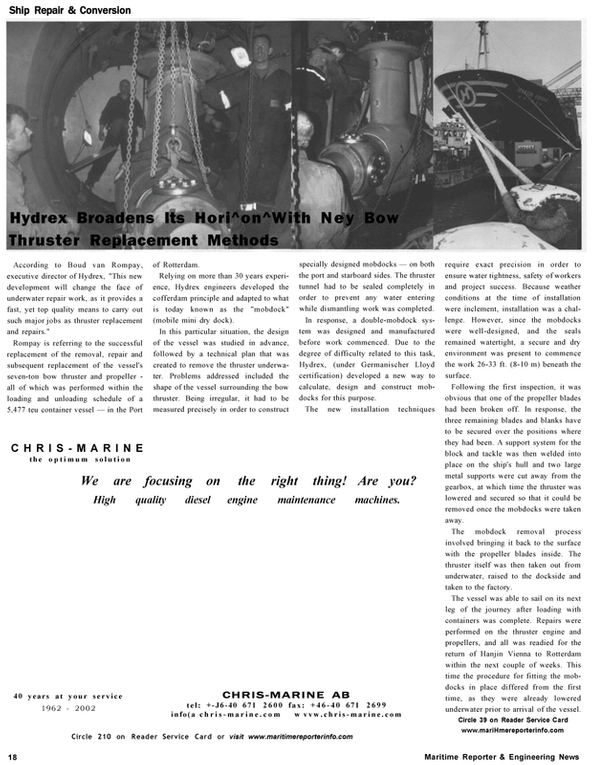
Hydrex Broadens Its Hori^on^With Ney Bow Thruster Replacement Methods
According to Boud van Rompay, executive director of Hydrex, "This new development will change the face of underwater repair work, as it provides a fast, yet top quality means to carry out such major jobs as thruster replacement and repairs." Rompay is referring to the successful replacement of the removal, repair and subsequent replacement of the vessel's seven-ton bow thruster and propeller - all of which was performed within the loading and unloading schedule of a 5,477 teu container vessel — in the Port of Rotterdam.
Relying on more than 30 years experience, Hydrex engineers developed the cofferdam principle and adapted to what is today known as the "mobdock" (mobile mini dry dock).
In this particular situation, the design of the vessel was studied in advance, followed by a technical plan that was created to remove the thruster underwater.
Problems addressed included the shape of the vessel surrounding the bow thruster. Being irregular, it had to be measured precisely in order to construct specially designed mobdocks — on both the port and starboard sides. The thruster tunnel had to be sealed completely in order to prevent any water entering while dismantling work was completed.
In response, a double-mobdock system was designed and manufactured before work commenced. Due to the degree of difficulty related to this task, Hydrex, (under Germanischer Lloyd certification) developed a new way to calculate, design and construct mobdocks for this purpose.
The new installation techniques require exact precision in order to ensure water tightness, safety of workers and project success. Because weather conditions at the time of installation were inclement, installation was a challenge.
However, since the mobdocks were well-designed, and the seals remained watertight, a secure and dry environment was present to commence the work 26-33 ft. (8-10 m) beneath the surface.
Following the first inspection, it was obvious that one of the propeller blades had been broken off. In response, the three remaining blades and blanks have to be secured over the positions where they had been. A support system for the block and tackle was then welded into place on the ship's hull and two large metal supports were cut away from the gearbox, at which time the thruster was lowered and secured so that it could be removed once the mobdocks were taken away.
The mobdock removal process involved bringing it back to the surface with the propeller blades inside. The thruster itself was then taken out from underwater, raised to the dockside and taken to the factory.
The vessel was able to sail on its next leg of the journey after loading with containers was complete. Repairs were performed on the thruster engine and propellers, and all was readied for the return of Hanjin Vienna to Rotterdam within the next couple of weeks. This time the procedure for fitting the mobdocks in place differed from the first time, as they were already lowered underwater prior to arrival of the vessel.
Circle 39 on Reader Service Card www.mariHmereporterinfo.com
Read Hydrex Broadens Its Hori^on^With Ney Bow Thruster Replacement Methods in Pdf, Flash or Html5 edition of October 2002 Maritime Reporter
Other stories from October 2002 issue
Content
- Fincantieri Proceeds on Costa Fortuna page: 8
- The Genoa Sestri Shipyard page: 9
- RoRo Vessel Jolly Rubino Runs Aground page: 10
- Rolls Royce Engine Passes Initial Tests page: 11
- Crescent Tankships Orders Product Tankers page: 11
- The Risks of Cargo and Maritime Security page: 12
- Hydrex Broadens Its Hori^on^With Ney Bow Thruster Replacement Methods page: 18
- Keppel Performs Speedy FPSO Conversion page: 19
- ASRY Holds Another Busy Quarter page: 20
- UMC Goes Beneath The Surface page: 20
- United Defense Receives Theater Surface Award page: 20
- Where Everyone is A Celebrity page: 21
- Gladding-Hearn Delivers New Bermuda Ferry Contract page: 22
- Fresh Fuel Cell Initiatives page: 24
- Simulating Evacuation page: 26
- Houston Celebrates Rickmers Hamburg's Maiden Voyage page: 27
- Purposeful Chinese page: 27
- Izar And Rolls-Royce Plan High Speed Cargo Vessel page: 27
- The Littoral Combat Ship: Force Multiplier for the 21st Century page: 28
- NASSCO Delivers USNS Soderman to U.S. Navy page: 31
- Family of Ships Employs Spiral Design page: 31
- New Warships Will Transform U.S. Navy page: 32
- "Start Spreading the News ..." page: 33
- Retired Radm. Foley to Lead Gulfport Facility page: 34
- UFRJ Wins Student Design Competition page: 35
- KMSS Maritime Black Box: More Than Just A VDR page: 40
- Tech Helps Ignite Gas Ship Market page: 43
- How Far Has E-Procurement Come in the Maritime Community? page: 44
- Coatings Corrosion — A Natural Predator page: 46
- Haraco Services Now Part of Miihlhan Group page: 51
- New DynaMatch System Provides Versatility page: 51


